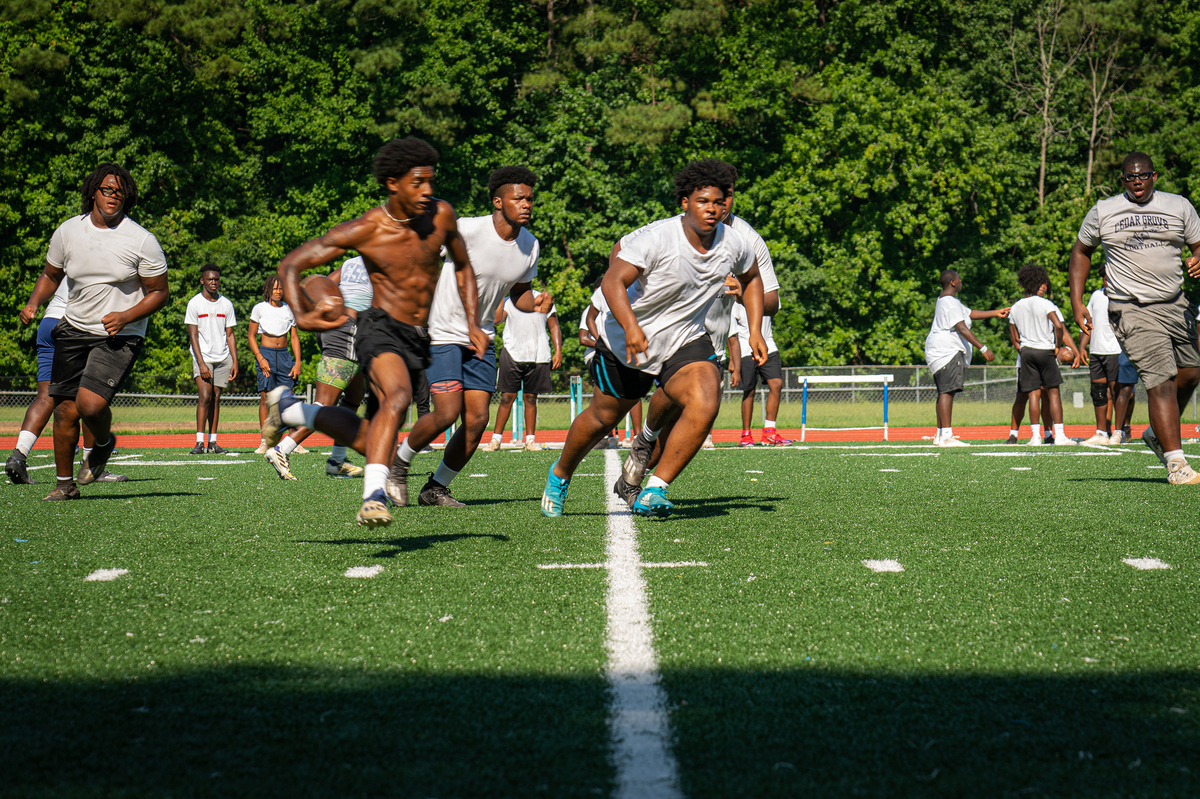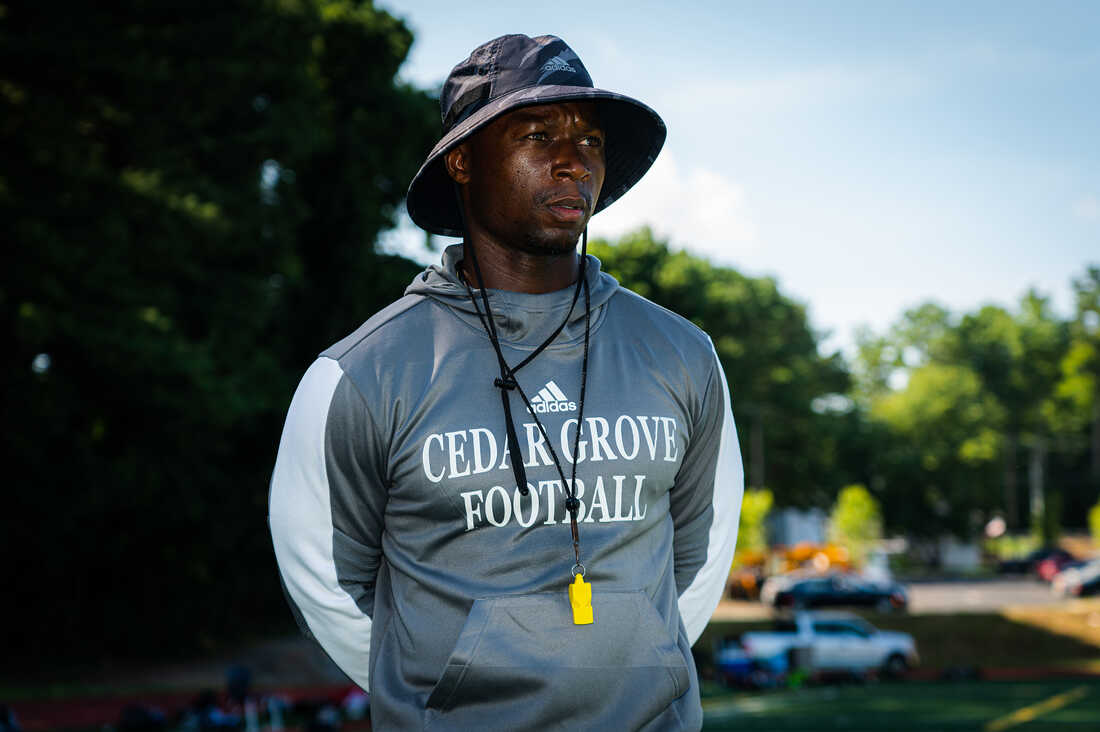Football players at Cedar Grove High School in DeKalb County will begin practicing without pads in late July to give them an acclimation period to adjust to the heat. This is a statewide rule by the Georgia High Schools Association.
Matthew Pearson/WABE
hide caption
toggle caption
Matthew Pearson/WABE

Football players at Cedar Grove High School in DeKalb County will begin practicing without pads in late July to give them an acclimation period to adjust to the heat. This is a statewide rule by the Georgia High Schools Association.
Matthew Pearson/WABE
ELLENWOOD, GA — High school football teams across the country begin training this time of year. Cedar Grove Saints.
On a muggy morning, the players practiced in the backyard of a high school outside of Atlanta with head coach John Adams providing guidance and encouragement.
this is a good team. They’ve won four state titles in the past six years, and four former Saints entered his NFL Draft this past year. This is more than any other high school in the country.
As such, Adams was excited for the upcoming season. But he also cared about keeping athletes safe as they trained in the Atlanta heat.
“The heat is getting to the point where it’s hard for everyone,” he said. “But I think with consistent conditioning in the heat, you’ll get used to it to some degree.”
He reminds his students to drink plenty of water even on days when they don’t practice. And he said he would check them during practice to make sure there weren’t any problems.
Football and the dangers of heat
From pros to college to high school, soccer players start practicing during the hottest months of the year. Much of it takes place on grassy fields that are roasting in direct sunlight. They wear many layers of armor, many of which are large, especially linemen.
It can lead to dangerous situations.
A University of Georgia study found that between 1980 and 2009, 58 Soccer players all over the country died of heatstroke. Most of them were high school students.
The study, published in 2010, found that the number of soccer players dying from the heat increased over time. It has one of the highest heat stroke deaths in the country.
But in the last decade, Georgia has turned things around. Experts said it reversed the trend of increasing numbers of athletes suffering from heatstroke. And the rules introduced here have become a model for other states trying to protect student-athletes from the heat.
This is all the more important as climate change will increase temperatures and humidity.
Water bottles littered the shady sidelines at Cedar Grove’s driving range. The team together he took a five-minute water break, but 17-year-old defensive his end Adonya Green said athletes could grab a drink whenever they needed it.
“You can always stay hydrated without water restrictions,” he said.
The players hadn’t put their pads on yet. By late July, they had become accustomed to practicing in the heat, limiting contact, banning tackling, and exercising without all equipment.
“When you pad it, it gets hot and heavy,” Green said. “It makes you tired.”
These are not just Cedar Grove policies. The Georgia High Schools Association mandates his five-day ramp-up period without pads when teams begin training.
Athletes must be allowed to hydrate whenever needed, and coaches are not allowed to force them to do drills as punishment.
During the hottest months of the year, teams should measure wet-bulb temperature before and during practice, taking into account not only heat and humidity, but also exposure to sunlight. Depending on that measure, the required rest is getting longer and longer, and in high temperatures, teams should be prepared to immerse players in ice baths if necessary.
When it gets hotter, outdoor practice is prohibited at all. No outdoor practice is permitted if the wet bulb temperature reaches 92 degrees.
Bud Cooper, a clinical professor of exercise at the University of Georgia who studies heat stroke and athletes, said that before the Georgia High Schools Association adopted these rules about a decade ago, schools did pretty much whatever they wanted. I was able to
But after the high-profile heat-related death of a high school football player, the association was ready to make a change.
“Obviously there was a problem,” said Cooper.

Cedar Grove head coach John Adams said the team’s focus is on preparation with the players.
Matthew Pearson/WABE
hide caption
toggle caption
Matthew Pearson/WABE

Cedar Grove head coach John Adams said the team’s focus is on preparation with the players.
Matthew Pearson/WABE
Protecting student-athletes
He and other UGA experts have designed heat rules based on their research. Cooper wasn’t sure how they would be received when they presented them to the high school association.
“The rules committee consisted of a group of five coaches, all of whom had probably 35 or 40 years of coaching experience, so people who have been around for a very long time,” he said. Said.
But the rules, which cover all high school sports, not just soccer, were adopted after relatively little discussion, he said.
Cooper and his colleagues conducted a follow-up investigation after the rule was enacted to confirm that it worked.
they did
Their study found that heat stroke was less common and there were no heat stroke deaths among high school football players in Georgia during a program that followed the rules.
“It’s exciting for me,” Cooper said. “There is nothing more satisfying than sitting here and saying, ‘I’ve done things that saved lives.'”
Georgia isn’t alone, according to Becca Stearns, chief operating officer of the Corey Stringer Institute at the University of Connecticut. The program, named after a Minnesota Vikings player who died of heatstroke, is an athlete safety research and advocacy program.
“Georgia is one of those states that has had a very deep impact in its influence and leadership when it comes to heat safety and policies enacted within the state,” Stearns said.
Rules backed by science
According to Stearns, what stands out in Georgia is that the rules are based on data and research. Other states have also been able to adopt Georgia’s model to protect student-athletes.
According to Stearns, 30 states have mandated some form of heat policy. Dozens of states base their policies on wet bulb global temperature.
Stearns said it’s more urgent now because climate change is raising temperatures and humidity.
In the future, Atlanta could see four times as many days too hot to exercise safely outdoors, according to another paper by UGA researchers. Increases are also being seen in other cities across the country.
“It’s certainly a very relevant conversation in terms of trying to act now before it gets even more intense,” Stearns said.

The Cedar Grove football team has a shady spot to take a break.
Matthew Pearson/WABE
hide caption
toggle caption
Matthew Pearson/WABE

The Cedar Grove football team has a shady spot to take a break.
Matthew Pearson/WABE
Experts stress that heat stroke deaths are preventable, but teams need to be prepared. Recognize the symptoms, treat anyone suffering from heat stroke as soon as possible, and cool the body before transporting it anywhere.
Parents of student-athletes should feel free to ask about their schools and states’ plans for the heat, Stearns said.
“The question always comes down to, ‘Who is responsible for the health and safety of high school athletes?’ And sadly, it’s not always a clear answer,” she said. “I would never drop a child into a pool without a lifeguard. It’s the same idea. We want to make sure these protections are in place before dropping a child out at a sporting practice.” ”
Cedar Grove’s Adams coach told him the key was to plan ahead, practice smart, and always keep the student’s best interests in mind.
“They are kids. So sometimes kids just try to reinforce it. But you have to be smart,” he said. “Life is more important than football.”


Commentaires
Enregistrer un commentaire